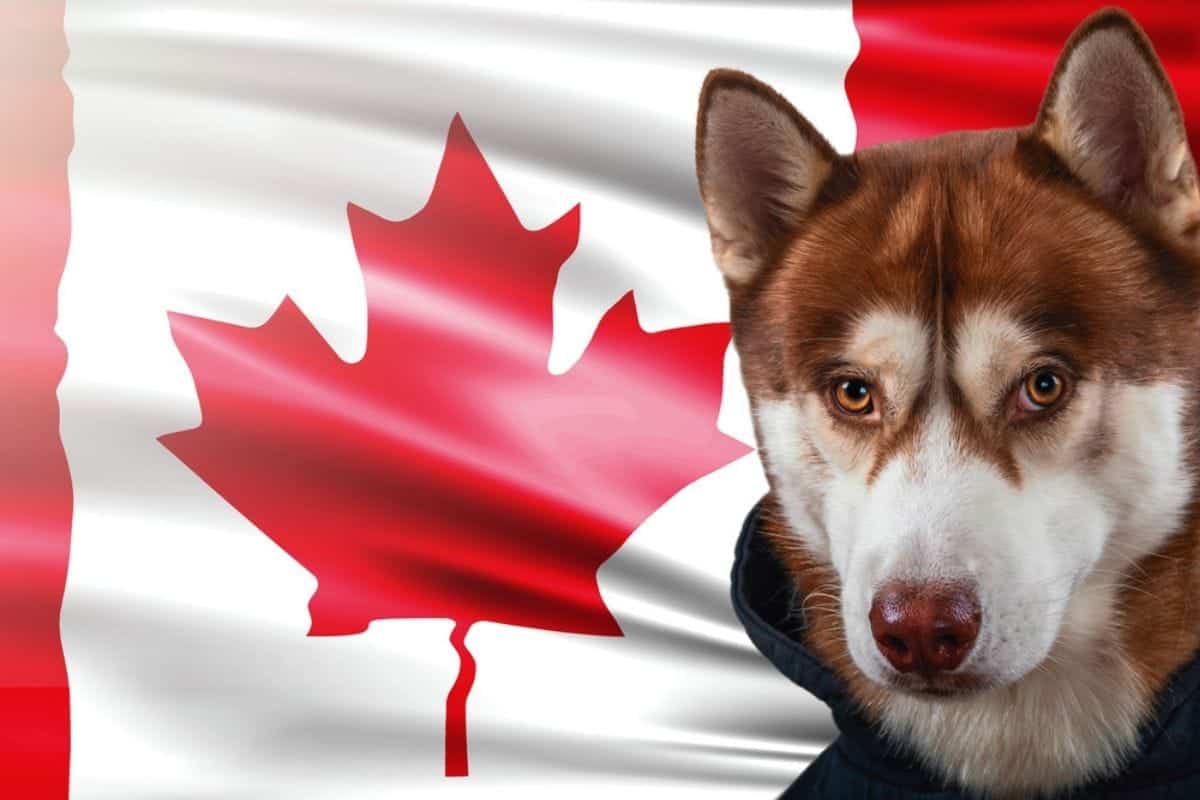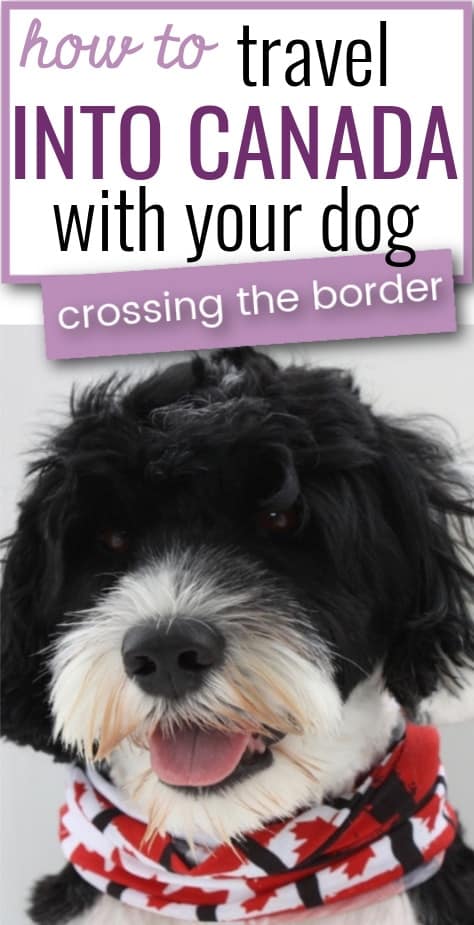Updated: March 12, 2021
Do you travel with your dogs? We live in Seattle, so traveling to Canada with a Dog is fairly common. Here are some tips and tricks to traveling into Canada with a Dog.
Bringing a dog into Canada is fairly easy. Since we live in Washington State, traveling into Canada with a dog is a quick trip across the border.
You may be nervous about taking your pets to Canada, but there's really no reason to worry. We've traveled across the border with our dogs a lot over the years, and we're sharing tricks we learned.
If you’re planning to travel to or through Ontario with a bully breed, please pay special attention to the “Breed Specific Legislation” section at the end of this post.
If you’re planning to travel to or through Ontario with a bully breed, please pay special attention to the “Banned Breeds Specific Legislation” section at the end of this post.

Rules for Bringing a Dog into Canada
Most U.S. citizens can travel freely to and from Canada, but only if they have the right papers.
Documents For Travel Between the US and Canada By Car
A visa is likely required for people traveling for work, school, or to move permanently.
If you're just visiting, you're allowed to stay in Canada for six months if you bring your U.S. passport and ID with you.
A passport will serve as proof of citizenship and identification. The following forms of identification may also be acceptable for those who meet the requirements:
- U.S. Passport Cards
- Enhanced Driver’s Licenses
- Trusted Traveler Cards (Global Entry*, NEXUS, SENTRI, or FAST)
- Military Identification Cards (for members of the U.S. armed forces on official orders)
- U.S. Merchant Marine Document (for U.S. citizens on official maritime business)
Pet-Friendly Hotels When Traveling to Canada
If you're staying overnight in Canada, you'll also need a great pet-friendly hotel!
Canada has plenty of pet-friendly hotels, and you can easily find the right one by searching online.
Requirements for Bringing a Dog into Canada
The Canadian Food Inspection Agency controls the policies for what is required to bring your dog into Canada by car. Seems a little strange right! But they do control pets and food. You can find the link here.
Before heading to the border with an animal, make sure you understand the Canadian import and travel requirements.
The Canadian Food Inspection Agency sets the policies for traveling with your pets to Canada. Their officers inspect and can an animal if:
- It is undeclared, including family pets.
- You do not have the permits/certificates.
- It is suspected of being sick or infected with a pest or disease.
- The animal is transported in a non-humane way and not kept safe from harm and injury.
Proof of Rabies Vaccination
The only thing the older dogs need is a current rabies vaccination. For puppies under three months, you must provide proof of age upon request.
The official statement explains what is on a rabies certificate:
Domestic or pet dogs may enter Canada if accompanied by a valid rabies vaccination certificate. A licensed veterinarian must issue the certificate in English or French and clearly identify the dog by breed, color, weight, etc.
The certificate must state that the pet is currently vaccinated against rabies and indicate the trade name of the rabies vaccine used, including serial number and duration of validity (up to three years).
The vaccination will be considered valid for one year, unless otherwise indicated.
Canada does not impose a quarantine on pets arriving from any country. Canada does not require a vaccination waiting period.
Your pet is welcome to enter Canada immediately after he or she receives the rabies vaccination.
Are the Rules the Same for My Puppy?
Pets younger than three months do not need vaccinations, or proof of vaccinations, to enter Canada.
However, as mentioned above, you need to return to the US 30 days before entry.
If you're staying longer than 30 days in Canada and are planning to visit a vet for a Rabies vaccination, at least 30 days before your planned return to the US, you're good to go.
What If You Don’t Have a Valid Rabies Certificate?
There are no exceptions to the rabies requirement. Unfortunately, dogs who have had a titers test, or whose veterinarian has recommended against administering the vaccine due to age or health, are not exempt.
Going to the border without a proper rabies certificate means more hoops to jump through.
Your dog has to get a rabies shot within two weeks of arrival. After the vaccination, you'll need to submit a vaccination record to a Canadian Food Inspection Agency.
Besides the vaccination costs, you'll also pay $55.00 + tax for the first animal and $30.00 + tax for each additional animal. These fees are due when you cross the border.
Pets Must Be Transported Safely
Canada also sets guidelines for transporting animals humanely. Follow these tips to keep your pets safe when you're away:
Pets should be contained if they might distract the driver. Some animals, such as cats, might be more comfortable in a vehicle when’re in a carrier. Pets should never run around in the back of pickups or exposed to flying debris.
Animals can't stay in a parked vehicle for long periods of time, especially during hot or cold weather. If you need to leave your pet in a vehicle for a while, make sure it has fresh water and open the windows on both sides to create a cross-breeze.
Make sure your pet gets food, water, and rest on long trips and that you stop frequently so it can rest or get out.
Can I take my pet’s food to Canada?
Yes, but there are a few rules. They allow pet food into the country if:
- It weighs less than 20 kilograms (or 44 pounds).
- It’s manufactured in the U.S. and commercially packaged.
- It’s in your possession at the point of entry.
- The dog who will eat the food is with you at the border.
Taking Pet Food and Treats into Canada
Pet travelers from the U.S. can bring up to 20 kg (44 pounds) of pet food and treats into Canada, provided they meet all the following requirements:
- Pet food and treats must be bought in the US, unopened, and commercially packaged.
- The dog food should be in your possession when you enter the country.
- The dog eating the products must be present at the time of entry.
- The foods must only be fed to pets brought into Canada by travelers.
If you're taking a longer trip, or if you're flying into Canada, bring dehydrated pet food.
Bringing A Dog into the U.S. From Canada
All dogs have to be healthy to enter the United States. In addition, the dog may need a valid rabies vaccination certificate.
Health Certificate When Entering the U.S.
Like in Canada, you don’t need a health certificate if your dog is in good shape.
If there could be any question about his health, we recommend getting a health certificate from a veterinarian that’s not contagious.
Taking Pet Food and Treats from Canada back into the U.S.
- The food contains no lamb, sheep, or goat meat.
- Food must be unopened, shelf-stable, and not need refrigeration.
- The package must clearly say what's in it and where it comes from.
- The food is manufactured in Canada or the United States.
Micro-chips for Dogs
Canada does not require pets to be micro-chipped. However, if your pet gets lost or separated during travel, I recommend that you have a microchip.
Moving to Canada with Pets
There are other types of pets that you can import into Canada. Check out the CFIA’s website for more information.
Exemptions for moving to Canada with a dog
Pets that are three months and under and service dogs are exempt from the rabies vaccination requirement when moving to Canada.
The CFIA says a service dog is “a dog that provides a distinct, trained service to individuals who would otherwise be limited in their ability to perform certain tasks.”
If a service dog is accompanied by the person they help and the official documents that state they’re a service dog, all import requirements don't apply.
The other exemption is puppies and kittens under three months old. They aren’t old enough to get the rabies vaccination, so they don’t need rabies certification to cross the border. However, you'll have to show proof of age upon request.
Banned Dog Breeds in Canada
Before bringing your pet to Canada, check if they're allowed. Certain breeds are forbidden in specific places in Canada.
Dogs banned from entering Ontario and Winnipeg:
- American Staffordshire Terrier
- American Pit Bull Terrier
- Staffordshire Bull Terrier
- Pit Bull Terrier (only banned from Ontario)
Final Thoughts
You may also be interested in reading, Taking Your Pet to Canada from the folks at GoPetFriendly.
This page has more information on border crossing requirements for humans and a special warning if you're traveling into Ontario.


Leave a Reply